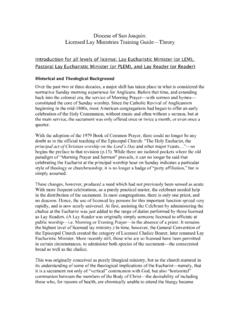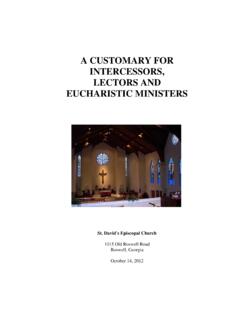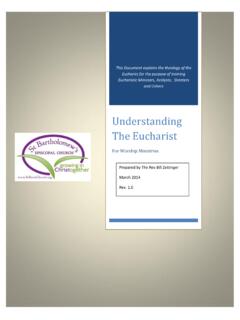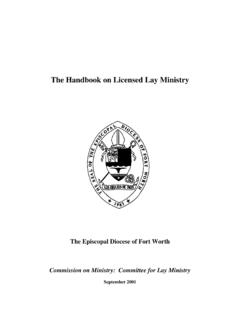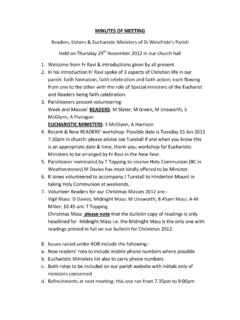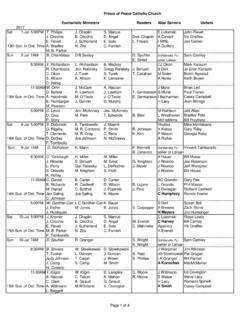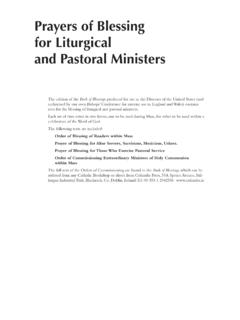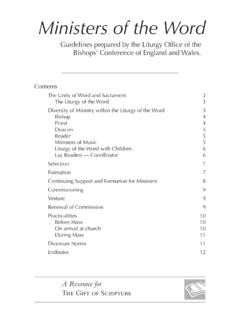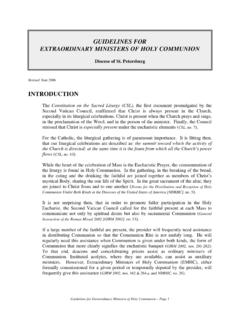Transcription of Lay Eucharistic Minister Training Outline 2014 - SaintJ
1 LAY Eucharistic Minister Training Saint James Episcopal Church, Fremont The Reverend Kenneth W. Parris, CMC Opening Prayer God of Abundance, you have formed your church as an on-going expression of your grace and love for humanity. Among the people of the church you have called some to the ministry of your Holy Sacrament. Be present with those whom you have called to serve among your people as Lay Eucharistic Ministers. Fill them with your life giving Spirit so that those to whom they Minister may experience the Real Presence of our Lord Jesus Christ in the Sacrament they share. May the act of giving they exercise before your altar and in the midst of your people be manifest in their daily lives among those with whom they live, work and worship. All this we ask in the name of your Son Jesus Christ who gifted the church with the Holy Eucharist in his words, Do this in remembrance of me.
2 Introduction of LEMs Name? How long an LEM? How long ago trained as an LEM? What do you hope to get out of this Training session, if anything? High point of the liturgy for you, personally? Scriptural Origins of the role of LEM Levites Members of the Tribe of Levi were dedicated to service of the temple. Moses and his brother Aaron, the first High Priest, were Levites. While the descendants of Aaron became the line of Jewish priests called the Kohenim, the other members of the Tribe of Levi were dedicated to tabernacle and later temple service, assisting the Kohenim in their sacred duties. The First Holy Eucharist We understand Jesus established the first Holy Eucharist at the Last Supper on what we call Maundy Thursday, the night before his arrest and crucifixion.
3 From Jewish custom that Jesus practiced, he did not personally share the bread and wine with all present. Instead, the bread and the cup were most likely shared among the apostles, each in turn presenting the cup to his brother. In doing this the apostles acted as the very first Eucharistic Ministers. Commissioning of the Seven While generally identified as the calling of the first seven deacons, the account in Acts of the Apostles setting apart seven men to serve tables among the Hellenist widows and orphans prefigures the ministry 1 Original prayer composed by the Reverend Kenneth W. Parris; Permission for use granted with attribution, 2014 Lay Eucharistic Minister Training Page 2 of 7 March 29, 2014 performed by LEMs.
4 While the apostles taught, the seven waited tables and ensured even the marginalized in the community received their fair share of the community s resources. Orders of Ministry in the Western Church: Past and Present2 Former Minor Clerical Orders of the Church o Doorkeeper o reader o Exorcist o Acolyte Former Major Clerical Orders of the Church o Subdeacon (Suppressed following Vatican II) o Deacon o Priest (Which included priest and bishop) Current Orders of Ministry in the Church3 o Laity o Bishops o Priests o Deacons Former Roles of Minors Orders and Subdeacon Assumed by the Laity Doorkeeper Became the lay ministries of greeter, usher and oblation bearers Readers Became Lector but essentially remained the same but gained the responsibility of Epistlers (The reader of the Epistle lesson.)
5 Exorcist Generally disappeared but remnants can be seen in the role of the healing prayer Minister . Acolyte Remained primarily intact but generally given to younger church members. Some duties fall under additional duties performed by LEMs. Subdeacon Essentially expressed years after its suppression in the ministry of the LEM. Deacon as Chief Steward While the deacon of the table is the Chief Steward of the Eucharistic meal, LEMs inherited the role of stewards from Subdeacons. I use this analogy to provide you with a better understanding of the relationship of the ministries between the deacon and the lay ministers. 2 The Great Schism created the Western Churches whose patrimony is to the Bishop of Rome and the Eastern Churches whose patrimony is to the Bishop of Constantinople.
6 The Eastern Orthodox Churches still employ the office of subdeacon as a minor order in addition to the other minor orders. 3 Book of Common Prayer, Page 855, 1979 Lay Eucharistic Minister Training Page 3 of 7 March 29, 2014 (Never forget, as an LEM you are a LICENSED Minister . You have been called, trained and empowered to perform your important ministerial role in the community of the faithful.) A brief comment about deacons in the Holy possible, it is desirable to have two deacons serve in the Holy Communion service. One is designated the Deacon of the Word while the other is Deacon of the Table. The Deacon of the Word is responsible for all that occurs in the service up to and including the Proclamation of the Gospel. The Deacon of the Table is the Chief Steward of the Eucharistic meal, setting the Holy Table, preparing the gifts, ensuring the Sacrament is distributed and the Holy Table is cleared.
7 This deacon usually stands to the right of the presiding priest while the Deacon of the Word stands to his/her left. The Deacon of the Word generally gives the Dismissal at the end of the service. LEMs primarily assist the Deacon of the Table in their duties as stewards. (Use the analogy of the church as a boat, perhaps a schooner what plies the seas on the winds of the Holy Spirit, with Jesus as its Captain, the presiding priest as the Quartermaster or Pilot, deacons as the Chief Steward and Chief Boatswain s Mate, and the people as stewards, cooks, deck crew, riggers, etc.) Liturgical Preparation and Practicum for LEMs4 Arrival and Vesting PLEASE, wash your hands before the service. You are handling items that will come in contact with peoples mouths.
8 We should practice good hygiene out of respect for our sisters and brothers in the congregation. Street Clothing Be aware of the thickness of the alb you wear. Many are made of thin, translucent fabric that will not do well in covering bright colors or bold patterns that may be on your street clothes. You do not want to wear anything that may be distracting or draw attention to you while serving. Shoes Shoes should be comfortable and also conservative. It is recommended for women to not were high heels as they can pose hazards for the wearer while serving. (I saw a LEM in high heels trip once and spill an entire chalice of consecrated wine on a member of the congregation. A very, very awkward moment indeed! Since the wine was consecrated, the altar guild insisted on laundering the congregation member s clothing to ensure none of the consecrated wine was sent to the sanitary sewer during cleaning.)
9 Hair and Head Covering Like clothing, hair styles should be conservative and head coverings should be avoided. Again, all the ministers at the altar, except 4 Refer to St. James Customary for Lay Eucharistic Ministers. Lay Eucharistic Minister Training Page 4 of 7 March 29, 2014 perhaps for the presiding priest, should blend unobtrusively into the surroundings and not draw attention to them selves. To do so potential disrupts the worship experience of not only the congregation but also the presiding priest. Crosses and Religious Medals Some third order members, oblates and associates of religious orders wear a cross or medal presented by their order or religious community while wearing an alb. This is acceptable and even encouraged as it adds to the diversity of our Eucharistic community.
10 LEM who are not members of such religious communities may also choose to wear a cross or religious medal while vested and serving. This too is acceptable so long as the cross or medal is conservative and is religious (in particular, Christian) in nature. Large pectoral crosses should be avoided as they generally indicate the person is a bishop, abbot or holder of some other clerical office. Tying the Cincture A simple slip knot moved to one side, traditionally the right side (but the left is alright too), is fine. The fancy tying of the cincture was actually a late development to facilitate controlling the priest s stole, nothing more. Preparing for the Entrance Procession Before the procession, approximately 10 minutes or so before the procession begins, check with the Deacon or Priest to find out if there are any seasonal (special holy day) or ritualistic changes (baptism, commissioning, etc.)
